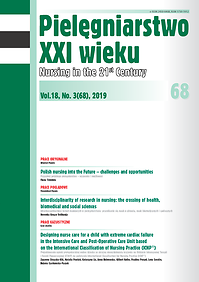Designing nurse care for a child with extreme cardiac failure in the Intensive Care and Post-Operative Care Unit based on the International Classification of Nursing Practice (ICNP®)
DOI:
https://doi.org/10.2478/pielxxiw-2019-0027Keywords:
ECMO, ICNP, intensive care unit, post-operative unit, cardiac failure, nursing careAbstract
DESIGNING NURSE CARE FOR A CHILD WITH EXTREME CARDIAC FAILURE IN THE INTENSIVE CARE AND POST-OPERATIVE CARE UNIT BASED ON THE INTERNATIONAL CLASSIFICATION OF NURSING PRACTICE (ICNP®)
Aim. The purpose of the work is to present nursing care for a pediatric patient with extreme circulatory failure, assisted by a device to Extracorporeal membrane oxygenation (ECMO) in the Intensive Care and Post-Operative Care Unit (ICPOCU) based on the International Classification of Nursing Practice (ICNP®).
Material and methods. The work uses the individual case method based on the following techniques: analysis of medical records, observation and measurement of vital signs.
Results. The most common and most dangerous care problem that may occur during therapy in extreme circulatory failure is the risk of cardiac dysfunction [10037314]. In this situation, the only life-saving method is often to support the circulatory and respiratory systems with the ECMO method. Another care problem is the risk of pressure sores [10027337]. The main goal of nursing care is to prevent their creation by minimizing risk factors and monitoring the patient’s skin condition. The problem of bleeding risk was also identified in the analyzed case [10017268] due to the need for heparin treatment. The goal of care is to minimize the risk and possible effects of bleeding. Because of taking care of the newborn baby, it is very important in planning activities to take into account the needs and problems of carers. One of the diagnosed problems is caregiver stress [10024773].
Conclusions. Nursing care for a pediatric patient with extreme circulatory failure supported by ECMO apparatus due to the impact of blood circulation on the functioning of the whole body does not focus solely on cardiovascular problems.
References
1. Karolczak M. red. Wykłady o sercu i kardiochirurgii wad wrodzonych. Lublin: Wyd. Czelej; 2008.
2. Malec E, Januszewska K, Pawłowska M. Moje dziecko ma wadę serca. Warszawa: Wyd. Fundacja Mam Serce. Fundacja na rzecz Dzieci z Wadami Serca Cor Infantis; 2014.
3. Masarone D, Valente F, Rubino M, et. al. Pediatric Heart Failure: A Practical Guide to Diagnosis and Management. Pediatr Neonatol. 2017; 58 (4): 303-312.
4. Kim H, Yang JH, Cho YH, et. al. Outcomes of extracorporeal membrane oxygenation in children: An 11-year single-center experience in Korea. Korean J Thorac Cardiovasc
Surg. 2017; 50 (5): 317-325.
5. Strudwick G, Hardiker N.R. Understanding the use of standardized nursing terminology and classification systems in published research: A case study using the International Classification for Nursing Practice®. Int J Med Inform. 2016; Oct 94: 215-21.
6. International Council of Nurses (ICN). data dostępu: [11.07.2019r.]. https://www.icn.ch/what-we-do/projects/ehealth/icnp-browser
7. Krupa S, Krukowska-Sitek H, Widenka K. ECMO jako metoda Nowoczesnej Intensywnej Terapii – opis przypadku. Pielęgniarstwo w Anestezjologii i Intensywnej Opiece. Evereth Publishing. 2017; 3 (3): 171-174.
8. Mysiak A, Kobusiak-Prokopowicz M. Intensywna terapia we współczesnej kardiologii. Fam Med Primary Care Rev. 2012; 14 (2): 262-269.
9. Azizov F, Merkle J, Fatullayev J, et. al. Outcomes and factors associated with early mortality in pediatric and neonatal patients requiring extracorporeal membrane oxygenation for heart and lung failure. J Thorac Dis. 2019; 11 (6): 871-888.
10. Henderson N, Sullivan JE, Myers J, et. al. Use of thromboelastography thrombotic complications in pediatric and neonatal extracorporeal membranous oxygenation. J Extra Corpor Technol. 2018; 50 (3): 149-154.
11. Schindler ChA, Mikhailov TA, Kuhn EM, et. al. Protecting fragile skin: nursing interventions to decrease development of pressure ulcers in pediatric intensive care. Am J Crit Care. 2011; 20 (1): 26-34.
12. Iwata M, Han S, Hays R, et.al. Predictors of depression and anxiety in family members 3 months after child’s admission to a pediatric ICU. Am J Hosp Palliat Care. 2019; 5(6):547-53.
13. Hyotala K. Caring for pediatric heart failure patients with long term mechanical circulatory support. Crit Care Nurs. 2018; 38 (5): 44-56.
14. Kilańska D, Staszewska M, Urbanek N, i wsp. Planowanie opieki według międzynarodowego standardu ICNP w Podstawowej Opiece Zdrowotnej – studium przypadku. Probl Pielęg 2014; 22 (4): 546-552.
Published
Issue
Section
License
Copyright (c) 2019 Authors

This work is licensed under a Creative Commons Attribution-NonCommercial-NoDerivatives 3.0 Unported License.




